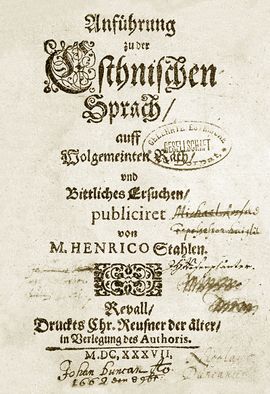اللغة الإستونية
| الإستونية Estonian | |
|---|---|
| eesti keel | |
| موطنها | إستونيا |
| العرق | الإستونيون |
الناطقون الأصليون | 1٫1 مليون (2012)e18 |
| اللاتينية (الأبجدية الإستونية) برايل الإستونية | |
| الوضع الرسمي | |
لغة رسمية في | |
| ينظمها | Institute of the Estonian Language / Eesti Keele Instituut, Emakeele Selts (semi-official) |
| أكواد اللغات | |
| ISO 639-2 | est |
| ISO 639-2 | est |
| ISO 639-3 | est – inclusive codeIndividual codes: ekk – Standard Estonian vro – Võro |
| Glottolog | esto1258 |
| Linguasphere | 41-AAA-d |
اللغة الإستونية ([eesti keel] Error: {{Lang}}: text has italic markup (help) [ˈeːsti ˈkeːl] (![]() استمع)) هي اللغة الرسمية في إستونيا، وهي اللغة الأم لحوالي 70% من مواطني إستونيا. ويتكلم بها نحو 1.1 مليون نسمة: 922,000 في إستونيا، و 160,000 خارج إستونيا.[1] وتنتمي إلى فرع اللغات الفينية من عائلة اللغات الأورالية. وتشبه الإستونية بحد مدهش اللغة الفنلندية.
استمع)) هي اللغة الرسمية في إستونيا، وهي اللغة الأم لحوالي 70% من مواطني إستونيا. ويتكلم بها نحو 1.1 مليون نسمة: 922,000 في إستونيا، و 160,000 خارج إستونيا.[1] وتنتمي إلى فرع اللغات الفينية من عائلة اللغات الأورالية. وتشبه الإستونية بحد مدهش اللغة الفنلندية.
. . . . . . . . . . . . . . . . . . . . . . . . . . . . . . . . . . . . . . . . . . . . . . . . . . . . . . . . . . . . . . . . . . . . . . . . . . . . . . . . . . . . . . . . . . . . . . . . . . . . . . . . . . . . . . . . . . . . . . . . . . . . . . . . . . . . . . . . . . . . . . . . . . . . . . . . . . . . . . . . . . . . . . . .
التاريخ

أقدم سجلات مكتوبة باللغات الفـِنـِّية في إستونيا يعود إلى القرن الثالث عشر. Originates Livoniae في Chronicle of Henry of Livonia يضم بالإستونية أسماء أماكن وكلمات وأجزاء من جمل.
الأدب الإستوني
الصوتيات
توجد تسعة أحرف متحركة و 36 diphthongs, 28 منهم هم أصليون في الإستونية.[1] All nine vowels can appear as the first component of a diphthong, but only /ɑ e i o u/ occur as the second component. A vowel characteristic of Estonian is the unrounded back vowel /ɤ/, which may be close-mid back, close back, or close-mid central.
| Front | Back | |||
|---|---|---|---|---|
| Unrounded | Rounded | Unrounded | Rounded | |
| Close | i | y | ɤ | u |
| Mid | e | ø | o | |
| Open | æ | ɑ | ||
نص كمثال
المادة الأولى من الإعلان العالمي لحقوق الإنسان بالإستونية:
Kõik inimesed sünnivad vabadena ja võrdsetena oma väärikuselt ja õigustelt. Neile on antud mõistus ja südametunnistus ja nende suhtumist üksteisesse peab kandma vendluse vaim.
(All people are born free and equal in their dignity and rights. They are given reason and conscience and they shall create their relationships to one another according to the spirit of brotherhood.)
انظر أيضاً
الهامش
- ^ Kilgi, Annika. 2012. "Eesti keel maailma taustal." Estonica: Entsüklopeedia Eestist.
للاستزادة
- Asu, Eva Liina; Teras, Pire (2009), "Estonian", Journal of the International Phonetic Association 39 (3): 367–372, doi:
- Ross, Jaan; Lehiste, Ilse (2001), The temporal structure of Estonian runic songs, The Hague: Walter de Gruyter, https://books.google.com/books?id=QYRwDHtxf9wC
